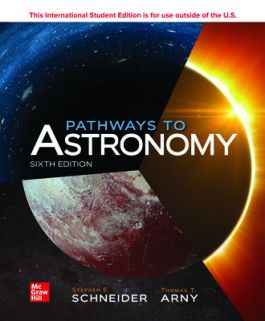ISE Pathways to Astronomy
Unit 1 Our Planetary Neighborhood
Unit 2 Beyond the Solar System
Unit 3 Astronomical Numbers
Unit 4 Scientific Foundations of Astronomy
Unit 5 The Night Sky
Unit 6 The Year
Unit 7 The Time of Day
Unit 8 Lunar Cycles
Unit 9 Calendars
Unit 10 Geometry of the Moon, Earth, and Sun
Unit 11 Planets: The Wandering Stars
Unit 12 The Beginnings of Modern Astronomy
Unit 13 Observing the Sky
PART II PROBING MATTER, LIGHT, AND THEIR INTERACTIONS
Unit 14 Astronomical Motion: Inertia, Mass, and Force
Unit 15 Force, Acceleration, and Interaction
Unit 16 The Universal Law of Gravity
Unit 17 Measuring a Body's Mass Using Orbital Motion
Unit 18 Orbital and Escape Velocities
Unit 19 Tides
Unit 20 Conservation Laws
Unit 21 The Dual Nature of Light and Matter
Unit 22 The Electromagnetic Spectrum
Unit 23 Thermal Radiation
Unit 24 Identifying Atoms by Their Spectra
Unit 25 The Doppler Shift
Unit 26 Special Relativity
Unit 27 General Relativity
Unit 28 Detecting Light - An Overview
Unit 29 Collecting Light
Unit 30 Focusing Light
Unit 31 Telescope Resolution
Unit 32 The Earth's Atmosphere and Space Observatories
Unit 33 Amateur Astronomy
PART III THE SOLAR SYSTEM
Unit 34 The Structure of the Solar System
Unit 35 The Origin of the Solar System
Unit 36 Other Planetary Systems
Unit 37 The Earth as a Terrestrial Planet
Unit 38 Earth's Atmosphere and Hydrosphere
Unit 39 Our Moon
Unit 40 Mercury
Unit 41 Venus
Unit 42 Mars
Unit 43 AsteroidsUnit 44 Comparative Planetology
Unit 45 Jupiter and Saturn: Gas Giants
Unit 46 Uranus and Neptune: Ice Giants
Unit 47 Satellite Systems and Rings
Unit 48 Ice Worlds, Pluto, and Beyond
Unit 49 Comets
Unit 50 Impacts on Earth
PART IV STARS AND STELLAR EVOLUTION
Unit 51 The Sun, Our Star
Unit 52 The Sun's Source of Power
Unit 53 Solar Activity
Unit 54 Surveying the Stars
Unit 55 The Luminosities of Stars
Unit 56 The Temperatures and Compositions of Stars
Unit 57 The Masses of Orbiting Stars
Unit 58 The Sizes of Stars
Unit 59 The H-R Diagram
Unit 60 Overview of Stellar Evolution
Unit 61 Star Formation
Unit 62 Main-Sequence Stars
Unit 63 Giant Stars
Unit 64 Variable Stars
Unit 65 Mass Loss and Death of Low-Mass Stars
Unit 66 Exploding White Dwarfs
Unit 67 Old Age and Death of Massive Stars
Unit 68 Neutron Stars
Unit 69 Black Holes
Unit 70 Star Clusters
PART V GALAXIES AND THE UNIVERSE
Unit 71 Discovering the Milky Way
Unit 72 Stars of the Milky Way
Unit 73 Gas and Dust in the Milky Way
Unit 74 Mass and Motions in the Milky Way
Unit 75 A Universe of Galaxies
Unit 76 Types of Galaxies
Unit 77 Galaxy Clustering
Unit 78 Active Galactic Nuclei
Unit 79 Dark Matter
Unit 80 Cosmology
Unit 81 The Edges of the Universe
Unit 82 The Curvature and Expansion of Universes
Unit 83 The Beginnings of the Universe
Unit 84 Dark Energy and the Fate of the Universe
Unit 85 Astrobiology
Unit 86 The Search for Life Elsewhere
McGraw-Hill Connect is an award-winning digital teaching and learning solution that empowers students to achieve better outcomes and enables instructors to improve course management efficiency.
High-Quality Course Material
Our trusted solutions are designed to help students actively engage in course content and develop critical higher-level thinking skills while offering you the flexibility to tailor your course to the ways you teach and the ways your students learn.
Assignments & Automatic Grading
Connect features a question bank that you can select from to create homework, practice tests and quizzes. Dramatically reduce the amount of time you spend reviewing homework and grading quizzes, freeing up your valuable time to spend on teaching.
Analytics & Reporting
Monitor progress and improve focus with Connect’s visual and actionable dashboards. Reports are available to empower both instructors and students with real-time performance analytics.
Seamless Integration
Link your Learning Management with Connect for single sign-on and gradebook synchronization, with all-in-one ease for you and your students.


